Aviary for Parakeets: Designing the Perfect Habitat


Intro
Creating an ideal environment for parakeets involves special considerations tied to both their physical space and social nature. Parakeets are intelligent and social creatures, requiring a habitat that enables not merely survival but stimulates their natural behaviors. This article delves into several aspects of parakeet care including practical tips on daily routines, understanding behavioral cues, serving balanced nutrition, ensuring overall wellness, and promoting their physical and emotional health through enriched activities.
Care Tips
Daily Care Routines
A consistent daily schedule is key to ensuring your parakeets thrive. Start each day by checking the aviary environment. Make sure the temperature, light, and cleanliness are optimal. Feeding should be done at a regularly scheduled time since birds enjoy routine.
Cage Setup and Maintenance
Parakeets require sufficient space to move. Choosing the right cage is paramount. It should be spacious, allowing room for flight and play. Cages should be made of materials safe for birds, such as stainless steel or powder-coated finishes. Check that all wires are secure and without sharp edges to prevent injuries. Regularly inspect the cage and its contents, ensuring they remain clean and safe.
Hygiene and Cleaning Practices
Cleaning is crucial for the health of parakeets. Cage bars, toys, and dishes should be cleaned daily. Wipe surfaces with bird-safe disinfectant. A full clean of the aviary should occur weekly, replacing substrates and thoroughly scrubbing all small components. Keeping parasite-free bedding helps create a healthy habitat.
Seasonal Care Adjustments
Consider adjustments based on the climate. In winter, provide extra warmth with additional materials like insulating blankets or heat lamps. In summer, ensure good ventilation and provide shaded areas within the aviary. Each change in season brings new challenges and opportunities to improve your feathered friends’ environment.
Behavioral Insights
Understanding Bird Body Language
Observing parakeet body language is essential for understanding their feelings and needs. Raised feathers may indicate excitement or aggression, while grooming behavior indicates a relaxed state. Attention to behaviors helps divine their moods, leading to better interaction.
Common Behavioral Issues and Solutions
Behavioral issues can include loud screeching or feather plucking. Identifying the source of these issues—be it boredom or stress—is crucial. Adapting their environment or increasing interaction can significantly improve their behavior over time.
Positive Reinforcement Techniques
Utilizing rewards when teaching your parakeet encourages desired behaviors. Whether it’s verbal affirmations, treats, or brief play sessions, positive methods create strong bonding and compliance.
Social Interaction Needs
Parakeets are naturally social animals; they thrive in environments with companions. Ensuring they have social interactions, whether with humans or fellow birds, can prevent loneliness and associated stress.
Nutrition Guides
Essential Diet Components
A rich and varied diet fortifies parakeets's vitality. Seed mixes should be supplemented with fresh fruits and vegetables weekly. Foods such as carrot, spinach, and appropriate berries cater to their nutritional needs. Acquaint yourself with reliable sources for parakeet dietary information, ensuring proper balance across nutritional components.
Safe and Toxic Foods
All bird owners should be aware of foods harmful to their pets. Avocado and chocolate should always be avoided, alongside primarily seed diets which can lead to malnourishment. Consult resources to better understand parakeet diet safety.
Supplements and Treats
Occasional supplements can be beneficial to bolster their vitamins. Cuttlebone and mineral blocks are excellent options. Treats should be healthy and presented in moderation.
Feeding Strategies for Different Species
Research on food requirements for various parakeet species is vital. While some variations might seem indistinct, they play an essential role in specific diets. Tailoring feeding practices based on specific needs enhances overall health.
Wellness and Health
Routine Health Checkups
Regular health checkups ensure any concerns can be addressed promptly. Visits to an avian vet should be scheduled at least once a year. Owners should watch for signs of distress or illness, learning to recognize subtle changes in routine or behavior.
Identifying Symptoms of Illness
Symptoms of possible illness may include lethargy, changes in feces, or unusual plumage. A fast response is beneficial; if noticing troubling signs, consult a veterinarian immediately rather than waiting.
Preventative Care and Vaccinations
Staying informed about potential illnesses common to parakeets equips owners to take preventive measures. Vaccinations may be recommended based on specific risks in your area—expert guidance is always beneficial.
Mental and Emotional Well-being
Health extends beyond the physical aspect. Parakeets require a mental challenge and a way to express their emotions. Rotation of toys and games can suffice to keep such stimulation alive.
Enriching Activities
Toys and Playtime Ideas
Toys should challenge and engage parakeets. Construct homemade toys or purchase diverse options that encourage climbing and solving tasks. Playtime not only promotes healthier exercise habits but enriches their lives mental.
Training and Tricks
Teaching tricks can be an engaging activity. Start simple, allowing time for learning and responding positively. Hours enjoyed training can increase bonding and enhance happiness.
Outdoor Activities and Interaction
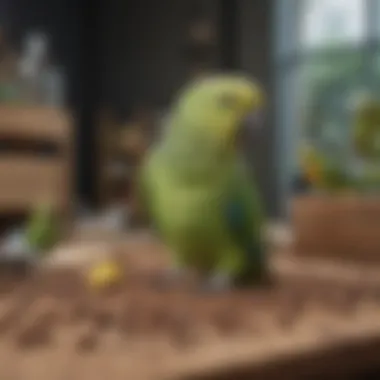
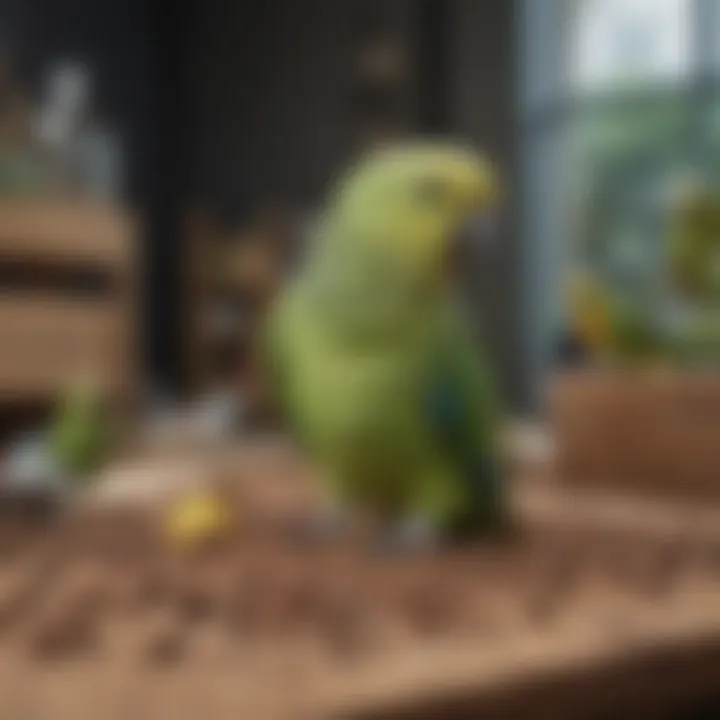
When possible, consider allowing your parakeet some outdoor time. Utilize bird-safe harnesses, under a watchful eye, to enjoy the fresh air and natural surroundings. Such activities can prevent boredom and enhance their social life.
DIY Projects for Mental Stimulation
Encouraging cognitive challenges through do-it-yourself projects can be rewarding for both parakeets and their owners. Simple activities such as maze-building or crafting treat dispensers stimulate their natural behaviors effectively.
Creating a healthy, stimulating environment for your parakeets is essential for their well-being and happiness. Whenever unsure about any aspect of care, reach out to experts and reliable resources for guidance, ensuring their enjoyment and fulfillment in your care.
Prolusion to Aviaries for Parakeets
Creating the optimal aviary for parakeets is a significant step in ensuring their health and happiness. Aviaries provide more freedom than traditional cages, allowing birds to engage in natural behaviors. This article will delve into the essence of why aviaries are important for parakeets and how they can lead to better well-being.
Importance of Aviaries
Aviaries serve as spacious habitats that simulate a bird's natural environment. When designed correctly, they promote physical health by encouraging exercise and social interactions. In aviaries, parakeets can fly, climb, and play, which is essential for their muscular and cardiovascular health. Importantly, a well-designed aviary reduces stress and anxiety by allowing birds to express their natural behaviors.
- Advantages of Aviaries:
- Enhance the quality of life for parakeets
- Facilitate social interactions between birds, leading to a more balanced habitat
- Offer freedom to fly and explore
When considering the importance of aviaries, one must also think about providing safety from predators and other hazards, which is easier in a controlled space. Selecting the correct location and materials is vital, establishing an aviary that benefits both the birds and their caregivers.
Understanding Parakeet Behavior
Parakeets are social creatures, often found in flocks in the wild. Understanding their behavior is crucial before constructing an aviary. These birds have specific social needs that, if met, result in a more harmonious environment. In an aviary, parakeets will engage in various activities such as foraging, preening, and vocalizing, imitating the rich social structures of their wild counterparts.
Key behavioral aspects:
- Communication: Parakeets communicate through chirps, whistles, and body language. When establishing an aviary, thoughtful consideration of how sound travels within the space will enhance their experience.
- Territoriality: Knowing their territorial nature helps in determining how the aviary should be set up, avoiding unnecessary conflicts.
- Hierarchy: Observing hierarchies among parakeets can provide insight into their group dynamics, promoting a peaceful coexistence within the aviary.
Understanding these behaviors arms owners with the knowledge needed to create a nurturing environment that caters specifically to parakeets' requirements. Compromising their natural behaviors can lead to significant stress and health issues, so careful planning is vital.
Choosing the Right Space
Choosing the right space is pivotal when it comes to creating a successful aviary for parakeets. The space impacts not only the physical structure of the aviary but also the well-being of the birds themselves. A properly chosen location can improve their health, encourage natural behaviors, and enhance overall happiness. It is essential to consider indoor versus outdoor environments, appropriate sizing, and the specific demands for sunlight and location when planning your setup.
Indoor vs.
Outdoor Aviaries
The decision to construct an indoor or outdoor aviary warrants thoughtful consideration. Indoor aviaries provide greater control over environment factors like temperature and humidity. They also protect birds from predators and harsh weather conditions. Additionally, hearing household activity can stimulate environmental enrichment for both you and the parakeets.
However, outdoor aviaries can afford birds a more enriching experience by providing varied sights, sounds, and air circulation. Having fresh, natural sunlight is positively influencing birds’ health, particularly in vitamin D production. Therefore, ideally, the choice should reflect not only your lifestyle but also the needs of the birds.
Size Considerations
Size is a crucial aspect of aviary design. Parakeets are active birds and thrive in an area where they can stretch their wings and enjoy free movement. Aviaries should be substantially larger than a standard cage, allowing parakeets to fly. A good rule of thumb is to provide a space where birds can fly from perch to perch.
A voidance of crowding and sufficient room contributes to better social dynamics among birds. The minimum recommended size for a parakeet avairy is generally agreed upon as 6 feet long by 2 feet wide by 2 feet high. However, larger sizes are always better. Prioritize multipurpose space that features vertical space for climbing as well as horizontal space for flying.
Location and Sunlight Requirements
Although often overlooked, location plays an integral role in setting up an aviary. It is important to examine sunlight exposure. Parakeets benefit greatly from regular exposure to daylight, not only for warmth but also for more overall health benefits. Natural light helps regulate their circadian rhythm, affording birds better sleep patterns and subsequently enhancing their moods.
Be mindful, however, of potential sources of excessive heat, like near windows or in direct sun during hottest parts of the day. Ensuring that birds can retreat to shaded areas and rest in cooler temperatures when necessary is essential. Selecting a shady spot with a refreshing breeze could contribute significantly to the comfort of your aviary occupants.
A suitable placement of the aviary is key to health and overall satisfaction of parakeets. Look for a quiet spot, away from drafts and disturbances that could inhibit a peaceful aviary environment.
Essential Materials for Construction
Choosing the right materials for constructing an aviary is critical. The materials not only dictate the durability of the structure but also influence the health and well-being of the parakeets. Parakeets require a safe and secure environment to live in, and the right choices can guard against hazards while fostering a stimulating environment. This section will delve into the essential elements involved in this aspect of aviary design.
Choosing the Right Frame Materials
The frame serves as the backbone of the aviary. Durable materials like aluminum or galvanized steel are preferred due to their resistance to rust and corrosion. Wood can be appealing, but it must be treated correctly or else it can decay
Benefits of Strong Frame Materials:
- Longevity: High-quality materials ensure the aviary lasts longer.
- Safety: Strong frames help prevent structural failures.
- Minimal Maintenance: Material durability contributes to lower maintenance needs over time.
Before selecting a material, please consider the climate in your area, as extreme temperature variations will wear down the materials rapidly. Moreover, think about how heavy your aviary will be and whether it’s permanent or temporary.
Selecting Safe Mesh and Netting
Mesh and netting play a key role in privacy and safety. Choices such as stainless steel wire, plastic-coated wire, and certain types of strong netting are essential. The strength of the mesh prevents breakage or escape, while maintaining good airflow within the structure.
Considerations:
- Gauge Rating: Choose a mesh with a suitable gauge to withstand challenges.
- Non-toxic: Always select safe materials that do not emit harmful toxins.
- Spacing: Ensure the spacing is narrow enough to prevent escapes or intrusion by predators.
Be meticulous here as poor selection could lead to serious consequences. A compromised structure leaves your parakeets vulnerable to predators or environments unsuitable for their health.
Flooring Options and Maintenance
The aviary floor can severely impact hygiene and safety. An essential thing is that whatever you choose should be easy to clean and prevent disease.
Recommended Flooring Materials:
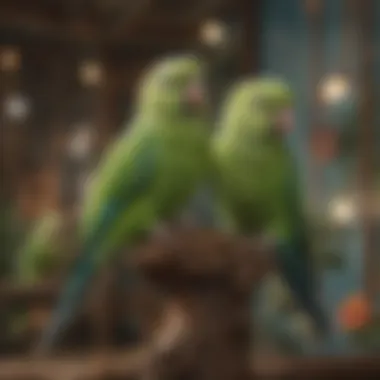
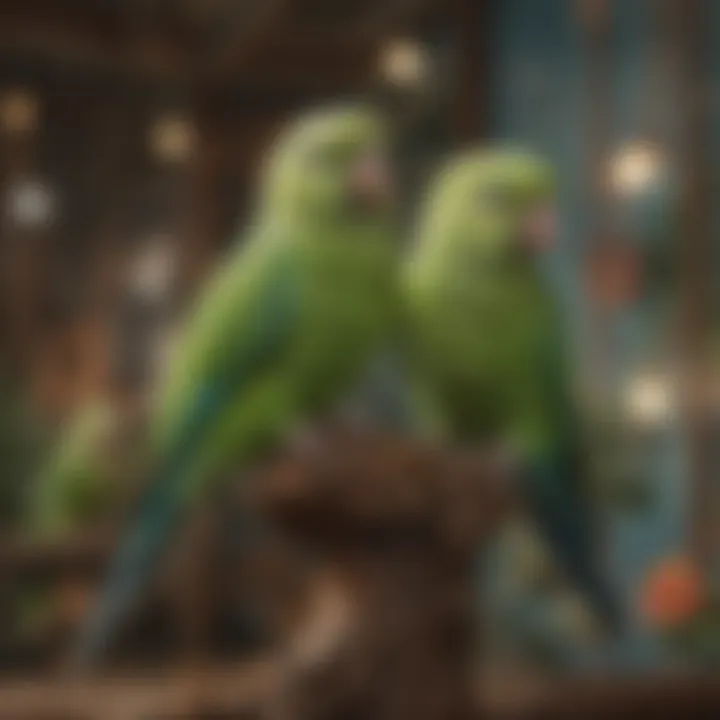
- Concrete: Non-porous and easy to sanitize; however, it can be harsh.
- Wood or Plywood: Attractive and soft but must be treated to resist rot.
- Sand: Real soft underfoot, but be careful dishes and wooden elements can get messy.
Regular maintenance is needed, regardless of floor choice. A poor flooring option can lead to higher humidity levels, attracting pests. Thus, creating a consistent cleaning regime is vital for any successful aviary.
"Maintenance is not an option; it is a necessity for bird welfare and aviary longevity."
Using the right materials in constructing an aviary is a blend of thoughtful design and understanding parakeets' needs. The safety, comfort, and health of the birds hang on well-made choices in material selection. Always tailor decisions based on specific environmental conditions and parakeet behavior to achieve the best for your aviary project.
Designing the Aviary Layout
Designing the layout of an aviary is a fundamental aspect that directly impacts the well-being of parakeets. An thoughtfully organized space allows these birds to engage in natural behaviors such as flying, exploring, and socializing. A cohesive layout not only addresses their physical needs but also stimulates their mental health. Therefore, paying careful attention to the design elements is vital.
Creating Flight Paths
Flight is essential for parakeets. Thus, establishing clear flight paths within the aviary should be the first consideration. These paths allow the birds to exercise their wings and strengthen their muscles. To achieve this, the design must ensure ample space between perches and platforms, fostering uninterrupted movement. Different levels and structures in the aviary can offer various heights for landing, mimicking their natural habitat and encouraging more flight.
- Consider varying heights: Use platforms that are both elevated and low to the ground.
- Plan open spaces: Maximize the open areas to reduce obstacles in their flight path.
Guiding them with designated routes excellently facilitates physical activity, this mimics the thrill they feel when darting through trees in the wild. Therefore, a successful aviary design allows for free movement without obstacles taking away enjoyment from strong, healthy flight.
Utilizing Perches and Platforms
Perches and platforms provide essential resting and social spaces for parakeets. The variety in perch types and placements caters to their innate preferences, promoting comfort during resting periods. It is crucial to choose the right materials and styles when selecting these elements.
Recommended perch materials could include natural wood, which provides texture and prevents wear on their feet. Consider using a combination of different diameters; this allows parakeets to flex their feet, thereby maintaining foot health.
Key tips for perch layout include:
- Spacing: Each perch should be spaced sufficiently to reduce squabbles and encourage individual exploration.
- Height: Vary perch heights to accommodate their skill levels; not all parakeets will immediately adapt to high platforms.
Incorporating ample perches and platforms will minimize stress among birds by enabling them to retreat from one another when they choose, enhancing their overall comfort.
Incorporating Enrichment Elements
Adding enrichment elements constitutes an important part of the aviary design. These elements should engage parakeets physically and intellectually. Parakeets are curious creatures who thrive in stimulating environments.
Consider the following addons to your aviary design:
- Toys: Include chew toys, swings, and hanging objects that can be interacted with. Rotate the toys regularly to keep them novel.
- Natural scenery: Log branches, plants, and safe soil can provide areas to play and explore.
- Foraging opportunities: Hiding food treats within these enrichment elements compels parakeets to think and encourages healthy foraging habits.
Keeping their environment fun and engaging is a huge factor in maintaining a balanced mood for parakeets. A lack of satisfaction can lead to boredom, resulting in undesired behaviors.
In summary, the design of an aviary layout is not merely aesthetic; it is functional and essential for the health and happiness of parakeets. Implementing inclusive flight paths, varied perches, and vivid enrichment opportunities can cultivate an optimal living space, promoting well-being that benefits both birds and their owners.
Maintaining a Healthy Environment
Maintaining a healthy environment is fundamental for the well-being of parakeets in an aviary. These birds require specific conditions to thrive both physically and emotionally. An optimal habitat not only provides space and materials but also ensures correct climate control, air quality, and sanitation. By focusing on these critical elements, parakeet owners can significantly enhance the quality of life for their birds, promoting longevity and joyful activity.
Temperature and Humidity Control
Parakeets have soft feathers and a lightweight body, which makes them particularly sensitive to temperature fluctuations. Ideally, the temperature in an aviary should range between 65°F and 80°F. An environment too cold can lead to cold stress, while excessive heat may cause overheating, which can be fatal.
Additionally, humidity levels are vital. The optimum humidity should generally be between 40% and 60%. Too much dry air can dry out their skin and feathers, potentially leading to issues like feather plucking. Alternatively, high humidity can foster mold and bacteria, which are harmful to birds.
Regular checks with a thermometer and hygrometer will help maintain these conditions. Vents, fans, and heating systems can assist in achieving these temperature and humidity levels. Protecting your parakeets from drafts and sudden temperature variations is equally important.
Air Quality Management
Air quality directly affects the health of birds. This includes the concentration of pollutants, dust, and odors that can build up in confined spaces. Insufficient air circulation can lead to respiratory problems and a general decline in well-being.
Ensure proper ventilation by selecting placement for the aviary that allows for natural airflow. Using air filtration systems or fans can also support fresh air circulation. Avoid using hazardous cleaning agents or products that can emit strong fumes within or near the living area of the parakeets.
Moreover, creating a smoke-free environment and limiting clutter will aid in maintaining a clean atmosphere free from airborne contaminants. Natural plant dedications can also enhance air quality. However, it is crucial to eliminate plant species toxic to birds before inclusion.
Regular Cleaning and Sanitation
Daily and regular cleaning routines play a significant role in fostering a healthy environment. As parakeets create waste, which can become a breeding ground for bacteria and parasites, it is essential to establish a thorough cleaning schedule.
Establish daily cleaning practices:
- Remove uneaten food to reduce spoilage and pests.
- Fresh water daily – ensure their drinking water is not only clean but also readily accessible.
Include weekly cleaning tasks:
- Disinfect horizontal surfaces, perches, and toys using safe bird cleaning alcohol.
- Regularly change the floor substrate, making sure to use specific bird-safe materials.
In addition to routine cleaning, focus on deep and thorough cleanings monthly. This involves delving deeper into corners, checking for hidden waste, and cleaning hard-to-reach spots. An overarching aim of maintaining cleanliness helps in safeguarding bird health and preventing infectious diseases.
Social Aspects of Aviary Life
Understanding the social dynamics of parakeets is essential for their well-being. In an aviary, parakeets are not solitary creatures. They thrive in social environments. Creating that environment requires careful consideration of companions, interactions, and hierarchies.
Choosing Compatible Companions
When selecting o companions for parakeets, various factors must be considered. Not all birds mix well together. Compatibility impacts their mental health. Some types of parakeets are more territorial. Being aware of species polices can avoid distress and disruptions.
- Species Compatibility: Budgerigars are common parakeets. Keeping them with other budgies or similar temperamental species is advised. Avoid housing them with aggressive or larger birds that could intimidate them.
- Personality Considerations: Each parakeet has its individual personalities. Some are social, while others prefer solitude. Observing their behavior can help find suitable companions. Mixed-bird aviaries should have carefully researched pairings to ensure harmony.
- Age and Gender Matters: Younger birds are likely to adapt better to the presence of others. Gender dynamics also play a role. Sometimes, male birds can be more dominant and may need appropriate oversight. Here careful notes on species characteristics will be indispensable.
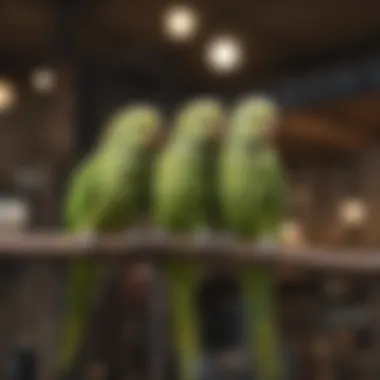
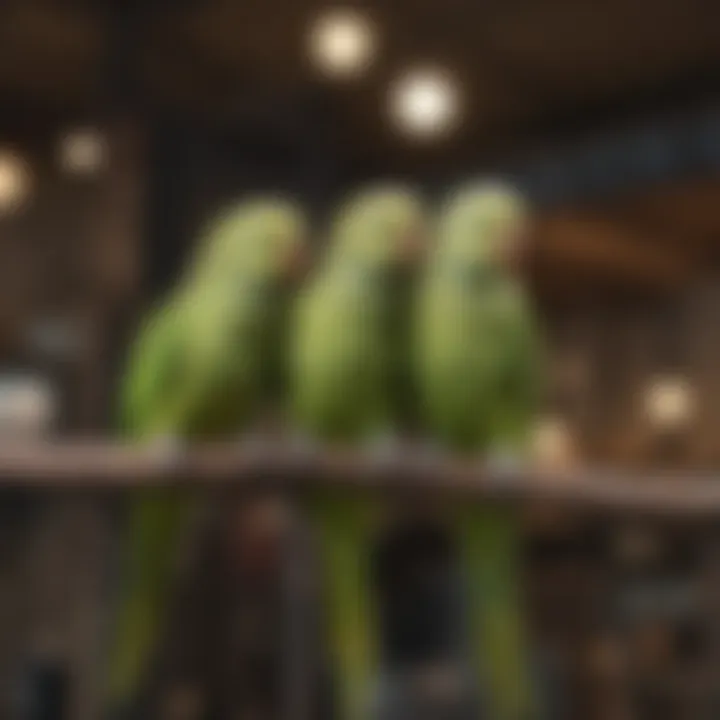
Monitoring Social Interactions
Monitoring interactions daily is necessary to ensure a peaceful aviary environment. Observing closely makes it possible to address any issues before escalating.
- Aggression Signs: Monitor for any aggressive behavior like chasing or pecking. Understanding the body language of parakeets helps detect tension.
- Positive Socializing: Look for signs of good interaction, such as preening or sharing perches. Encouraging these behaviors is vital. Reward positive interactions with treats to reinforce healthy dynamics.
- Behavior Diaries: Take down notes of social interactions. Documenting behavior could help make patterns visible and allows you to prescribe individual needs effectively.
Recognizing when social tension arises is critical. Regular attention keeps the peace.
Understanding Hierarchies and Bonding
The social structure in an aviary is not random; hierarchies can emerge based on behaviors and interactions. These dynamics must be understood for the proper care of parakeets.
- HierarchyFormation: Higher-ranked birds tend to showcase control over food sources and breeding parts. Observing these hierarchies reveal patterns of interaction and affinities.
- Bonding: Parakeets form strong bonds with their companions, essential for mental stimulation. Adults exhibit strong social structures where individual bonds exist alongside the collective aviary society.
- Fostering Relationships: Intentionally create circumstances that allow for bonding. Providing shared resources and climbing structures can foster these beneficial relationships.
Feeding and Nutrition for Parakeets
Feeding and nutrition are crucial aspects of ensuring the health and happiness of parakeets. Proper nutrition plays a vital role in their development, resilience to diseases, and overall well-being. This aspect of aviary care cannot be ignored or deemed secondary, as a balanced diet contributes directly to their longevity and activity levels. A focused approach on their dietary needs provides benefits not just for the birds, but for the owner too, as healthy birds lead to fewer complications down the road.
Understanding Dietary Needs
Parakeets are primarily granivorous, which means their diet mainly consists of seeds. However, relying solely on seeds can result in nutritional deficiencies. Parakeets require a balance of carbohydrates, protein, vitamins, and minerals to thrive. Incorporating fresh fruits, vegetables, and occasionally, fortified pellets can help achieve this balance.
Some important dietary components for parakeets include:
- Seed Mix: A blended variety of seeds like millet, canary seed, and sunflower seeds can make up the foundation of their diet.
- Fruits: Fruits like apples, pears, and berries offer essential vitamins and hydration.
- Vegetables: Leafy greens such as spinach or kale supply minerals and fiber necessary for digestion.
- Pellets: High-quality parakeet pellets can help monitor the nutritional intake more accurately.
It's also critical to ensure that treats or additional foods do not exceed ten percent of their total diet. Maintaining balance helps avoid obesity and encourages a healthier lifestyle.
Providing Varied Diets
Variety is key in providing the optimal diet for parakeets. Mixing different food sources not only keeps their feed interesting but also contributes to their overall nutrition. Parakeets, especially those in captivity, may get bored with the same foods.
Some tips for dietary variation include:
- Rotate Fruits and Vegetables: Introduce new items slowly. Use different combinations of fruits and vegetables on alternating days to diversify their intake.
- Include Grains: Offer whole grains like quinoa or oats occasionally. This adds both texture and nutrient variety.
- Avoid Unsafe Foods: Some types of food can be harmful such as avocados or caffeine. It's fundamental to stay informed about which foods are safe.
Engagement with your parakeet during feeding times can also help to socialize them, making mealtimes an avenue for bonding.
Fresh Water and Cleanliness
Providing fresh water is equally as important as the food they consume. Clean water ensures your parakeets stay hydrated. It aids their digestion and can even affect their mood. Dirty or stale water can significantly harm their health, fostering growth of bacteria or fungus.
Key practices include:
- Daily Changes: Ensure the water is fresh, ideally changed daily. It should be kept in a clean container, preferably stainless steel or ceramic to prevent contamination.
- Observe Water Intake: Make a note of how much water they are drinking to assess their health. Less consumption may indicate illness.
- Keep Clean Environment: Regularly clean food and water containers to eliminate everyday bacteria.
Establishing a clear routine for cleaning food and water dishes reinforces good hygiene, protecting your avian companions from sickness.
Tip: Regular cleaning solely does not substitute fresh provisions. Always prioritize daily replacements over hygiene reports alone.
Overall, attentiveness to feeding and nutrition will not only support the well-being of parakeets but also enrich the daily experiences in their aviary. Monitoring their eating habits and preferences creates a tailored approach ensuring that they are both happy and healthy.
Monitoring Health and Behavior
Monitoring the health and behavior of parakeets is essential for any bird owner. These small birds exhibit a range of behaviors and can easily hide their health issues. Understanding their actions and needs allows for early detection of potential problems, ultimately leading to better quality of life.
Recognizing Signs of Stress or Illness
Parakeets tend to mask symptoms of sickness. A discerning owner should observe their birds closely. Common signs of stress or illness include:
- Changes in behavior: Any abrupt shift in activity level, such as increased lethargy or excessive aggression.
- Changes in vocalization: A decrease in chirping can indicate that something is wrong.
- Feather condition: Ruffled feathers, over-preening, or feather loss can point to underlying health problems.
- Appetite changes: A loss of interest in food or increased water intake can signal issues.
- Posture and balance: Sitting alone with drooping wings or difficulty maintaining balance often requires closer inspection.
Prompt action can prevent these symptoms from escalating into more serious health matters. If several of these signs present themselves, consulting with an avian veterinarian is advisable.
Regular Veterinary Care
Routine veterinary visits form the cornerstone of good parakeet health management. Just like with any pet, regular check-ups help in preemptive care and health assessment. Key reasons for regular veterinary visits include:
- Preventive care: Getting vaccinations or fecal exams ensures any health threats are dealt with early.
- Nutritional guidance: A vet can recommend proper dietary choices conducive to the specific needs of your parakeet throws.
- Physical assessments: Regular weigh-ins help monitor health trends, spotting issues before they develop.
End
In building a home for parakeets, understanding the core elements associated with their habitat is very critical. The sections throughout this aricle have emphasized that parakeets need a well-designed aviary. Proper design uses adequate space and materials which prioritize the animal's well-being.
Regular attention to environment, nutrition, and social dynamics among parakeets greatly influences their health and behavior. Each choice made—from the aze of the aviary eventually impacts their quality of life. Efficient mate choice, dietary balance, exercise opportunity, and health vigilance combine to maximize their satisfaction in the aviary.
Recap of Aviary Essentials
- Space Usage: Ample room must be ensured; this promotes flying and natural behaviors.
- Construction Materials: If done right, can help keep parakeets safe.
- Environmental Conditions: Correct temperature and hygiene influence overall health.
- Nutritional Variety: Real food options supporting strength and quality life.
- Social Well-being: Selecting companions and their hierarchy is high on the list.
These essentials interact to protect and nurture every parakeet, enhancing daily experiences.
The Impact of a Proper Aviary on Parakeet Welfare
A functional aviary provides parakeets a chance to live as they would in the wild. When facilities are adequate and thought out, the parakeets can explore and thrive. Such living conditions reduce stress significantly. Happy parakeets are usually active and vocal, signalling their contentment.
Neglecting any critical areas discussed can impose stress and anxiety on the birds, which might result in health complications up to their sad death.
So, dogged focus on proper aeration, nutrition, maintenance, and the presence of congenial exhibitors ensures that your parakeets not only exist but also live fully engaged with their surroundings.
All this solidifies why understanding the importance of aviaries can enhance a parakeet's journey. Regular observations add further depth into ensuring every aspect of welfare rigor.
A well-designed aviary does not just serve as a home; it fosters a sanctuary that nurtures both the body and mind of a parakeet.















